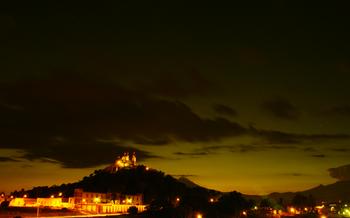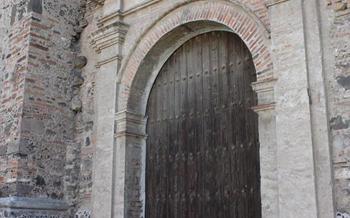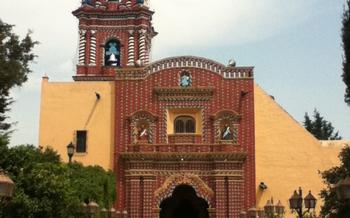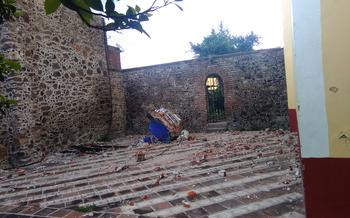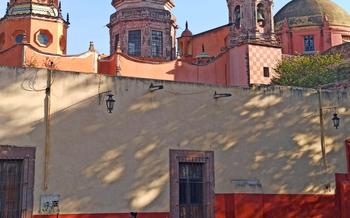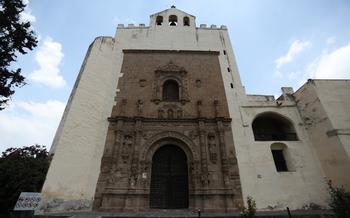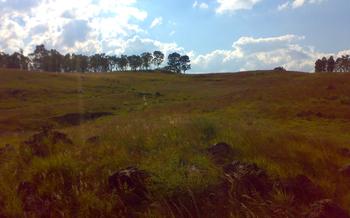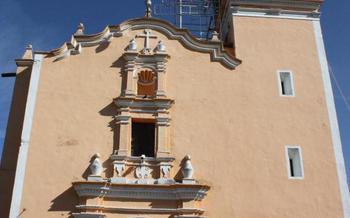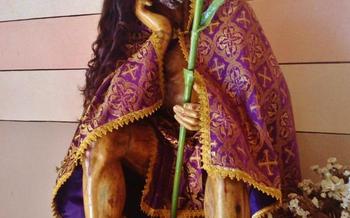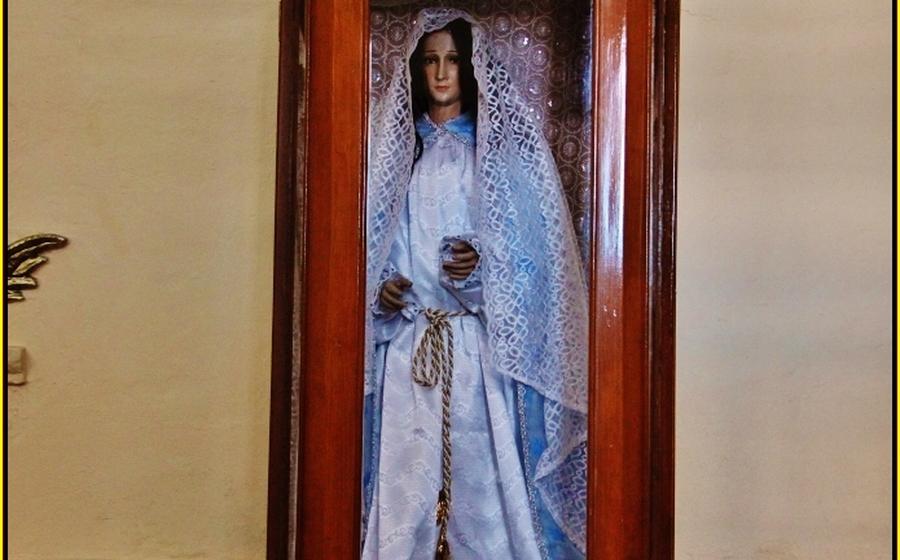
Templo de San Andrés Cholula
- The Templo de San Andrés Cholula
- The Architecture of the Templo de San Andrés Cholula
- Visiting the Templo de San Andrés Cholula
- Getting to the Templo de San Andrés Cholula
- Things to Do Near the Templo de San Andrés Cholula: Exploring the City of Cholula
- The Legend of the Sleeping Giant
- The Templo de San Andrés Cholula in Popular Culture
- The Templo de San Andrés Cholula and the Future
- The Templo de San Andrés Cholula in Numbers
- The Templo de San Andrés Cholula in Photos
- The Templo de San Andrés Cholula in Literature
- Insider Tip:
The Templo de San Andrés Cholula
The Pre-Hispanic Origins of the Templo de San Andrés Cholula
The Templo de San Andrés Cholula is a fascinating and unique building that stands as a testament to the rich history and culture of Mexico. Its origins can be traced back to the pre-Hispanic period, when the site was a major religious center for the indigenous peoples of the region. According to legend, the temple was built on the spot where a giant named Xelhua was turned into a mountain. The giant's body is said to be buried beneath the temple, and his spirit is believed to protect the site.
The Construction of the Church during the Colonial Period
During the colonial period, the Spanish conquistadors built a church on top of the pre-Hispanic temple. The church was completed in 1594 and dedicated to Saint Andrew, the patron saint of Cholula. The church is a beautiful example of colonial architecture, and it features a number of impressive frescoes and sculptures.
The Restoration Work Carried Out in the 20th Century
In the 20th century, the temple underwent a major restoration project. The project was completed in 1964, and it resulted in the restoration of the temple to its original condition. The temple is now a popular tourist destination, and it is considered to be one of the most important historical and religious sites in Mexico.
The Declaration of the Temple as a World Heritage Site by UNESCO
In 1987, the Templo de San Andrés Cholula was declared a World Heritage Site by UNESCO. This prestigious designation recognizes the temple's outstanding universal value and its importance to the cultural heritage of humanity. The temple is one of only a few sites in Mexico to have received this honor.
The Architecture of the Templo de San Andrés Cholula
The Templo de San Andrés Cholula is a unique architectural marvel that blends pre-Hispanic and colonial influences. Its most striking feature is its pyramid-like structure, which is the result of the superposition of several pre-Hispanic temples. The temple was built using local materials such as adobe and volcanic rock, which give it a distinctive reddish-brown color.
The Templo de San Andrés Cholula is one of the largest churches in Mexico, with a length of 85 meters and a width of 65 meters. The facade of the temple is adorned with intricate carvings and decorations, including figures of saints and angels. The interior of the temple is equally impressive, with beautiful frescoes, impressive altarpieces, and stunning stained glass windows.
The temple's unique architectural style has earned it recognition as a UNESCO World Heritage Site. It is a testament to the skill and artistry of the indigenous and Spanish craftsmen who built it. The Templo de San Andrés Cholula is a must-see for anyone interested in Mexican history, architecture, or religion.
Visiting the Templo de San Andrés Cholula
The Templo de San Andrés Cholula is open to visitors every day of the week from 9:00 AM to 5:00 PM. The cost of admission is 50 pesos for adults and 25 pesos for children. Guided tours of the temple are available in English and Spanish for an additional fee. Visitors are required to dress respectfully when visiting the temple, and shorts, tank tops, and flip-flops are not permitted.
The best time to visit the Templo de San Andrés Cholula is during the dry season, which runs from November to April. During this time, the weather is sunny and dry, making it ideal for exploring the temple and its surroundings. The temple is also less crowded during this time, so visitors can enjoy a more peaceful and intimate experience.
The Templo de San Andrés Cholula is located in the city of Cholula, which is about 100 kilometers east of Mexico City. The temple is easily accessible by public transportation, and several bus lines stop near the temple. There is also a parking lot near the temple where visitors can park their cars.
Once you have arrived at the temple, you can begin your visit by exploring the exterior of the building. The temple's facade is adorned with intricate carvings and decorations, and you can spend hours admiring the details. Be sure to look for the large bell tower, which is one of the most iconic features of the temple.
After you have explored the exterior of the temple, you can enter the interior. The interior of the temple is just as impressive as the exterior, and you will be amazed by the beautiful frescoes, altarpieces, and stained glass windows. Be sure to take your time to explore the different chapels and side altars, which are each unique and beautiful in their own way.
Getting to the Templo de San Andrés Cholula
The Templo de San state of Puebla, Mexico. It is situated on a hill overlooking the city, and is easily accessible by public transportation or taxi.
There are several different ways to get to the temple from the city center. The most common way is to take a taxi, which will cost around 50 pesos. You can also take a bus, which will cost around 10 pesos. There are several different bus routes that go to the temple, so be sure to ask for directions at the bus station.
If you are driving, you can take the Carretera Federal 190 from Puebla to Cholula. Once you are in Cholula, follow the signs to the temple. There is a parking lot located near the temple, where you can park your car for a small fee.
The temple is located about 10 kilometers from the city center, and the journey takes about 20 minutes by car or taxi. Once you arrive at the temple, you will need to climb a set of stairs to reach the entrance. The climb is not too strenuous, and it takes about 10 minutes.
The Templo de San Andrés Cholula is a popular tourist destination, so it is important to plan your visit accordingly. The best time to visit is during the week, when there are fewer crowds. The temple is open every day of the week, from 9am to 5pm.
Things to Do Near the Templo de San Andrés Cholula: Exploring the City of Cholula
The Templo de San Andrés Cholula is not the only attraction that the city of Cholula has to offer. Visitors to the temple should also take some time to explore the rest of the city, which is home to a variety of other interesting attractions.
One of the most popular tourist attractions in Cholula is the Great Pyramid of Cholula, which is the largest pyramid in the world by volume. The pyramid was built by the ancient Olmecs and is believed to have been a religious center. Visitors can climb to the top of the pyramid for stunning views of the city and the surrounding countryside.
Another popular attraction in Cholula is the historic center, which is home to many colonial-era buildings. The historic center is a great place to wander around and soak up the atmosphere of the city. Visitors can also find a variety of shops, restaurants, and cafes in the historic center.
For those looking for a more unique experience, Cholula is also home to a number of local markets. The markets are a great place to find souvenirs and try the delicious local cuisine. Visitors can find everything from fresh produce to handmade crafts at the markets.
No matter what your interests are, you're sure to find something to enjoy in Cholula. The city is a great place to spend a day or two exploring the many attractions that it has to offer.
The Legend of the Sleeping Giant
The Templo de San Andrés Cholula is closely associated with the legend of the sleeping giant. According to this legend, a giant named Cholula was turned into a mountain by the gods as punishment for his arrogance. The mountain is said to be the site of the temple, and the giant's head is said to be located beneath the altar.
The legend of the sleeping giant is significant to the people of Cholula, as it is a reminder of their history and culture. The legend is also a source of pride for the people of Cholula, as it represents their connection to the ancient past.
There are many different versions of the legend of the sleeping giant. Some versions say that the giant was turned into a mountain by the god Quetzalcoatl, while other versions say that he was turned into a mountain by the god Tezcatlipoca.
The legend of the sleeping giant has had a significant impact on the culture of Cholula. The giant is often depicted in local art and folklore, and the legend is often told to children as a bedtime story. The legend has also inspired a number of local festivals and celebrations.
The Templo de San Andrés Cholula in Popular Culture
The Templo de San Andrés Cholula has been featured in numerous works of popular culture, including movies, TV shows, and books. In the 1959 film The Nun and the Bandit, the temple serves as the backdrop for a love story between a nun and a bandit. The 2006 TV series Capadocia features the temple in a scene where a group of prisoners escape from a nearby prison. In the 2010 novel The Dream of Santa Teresa, the temple is mentioned as a place of pilgrimage for the main character, a young woman who is searching for her lost faith.
The temple's role in popular culture is significant because it helps to raise awareness of the temple and its history. By being featured in movies, TV shows, and books, the temple is able to reach a wider audience and inspire people to visit it. The temple's inclusion in popular culture also helps to promote Mexican culture and heritage.
The Templo de San Andrés Cholula and the Future
The Templo de San Andrés Cholula faces several challenges in the future. One of the most pressing issues is the need to preserve and protect the temple from environmental damage. The temple is located in a natural setting, but it is also subject to the effects of pollution and climate change. The local community and government are working together to develop strategies to reduce the temple's environmental impact and protect it from future damage.
Another challenge facing the temple is the need to ensure its long-term sustainability. The temple is a popular tourist destination, but it is also a place of worship for the local community. The challenge is to find a way to balance the needs of tourism with the needs of the local community. The local government is working to develop a sustainable tourism plan that will benefit both the temple and the community.
Despite these challenges, the future of the Templo de San Andrés Cholula looks promising. The temple is a symbol of Mexican history and culture, and it is a source of pride for the local community. The government and the local community are committed to preserving and protecting the temple for future generations.
The Templo de San Andrés Cholula in Numbers
- Height: 66 meters (217 feet)
- Width: 44 meters (144 feet)
- Length: 100 meters (328 feet)
- Number of steps leading to the top: 400
- Number of visitors who visit the temple each year: Over 1 million
- Number of years that the temple has been standing: Over 500
The Templo de San Andrés Cholula is a truly impressive structure, and its size is one of its most striking features. The pyramid-like base of the temple is the largest in the world by volume, and the temple itself is one of the largest churches in Mexico. The temple's height is also impressive, and the climb to the top of the temple is a challenging but rewarding experience. The views from the top of the temple are simply breathtaking, and visitors can see for miles in every direction.
The Templo de San Andrés Cholula in Photos
The Templo de San Andrés Cholula is a truly stunning sight, and there are few things more rewarding than capturing its beauty in a photograph. The temple's unique architecture, impressive size, and intricate carvings make it a photographer's dream.
Whether you're a professional photographer or simply someone who enjoys taking snapshots, you'll be sure to get some amazing shots of the Templo de San Andrés Cholula. Here are a few tips for taking great photos of the temple:
-
Use a wide-angle lens. This will allow you to capture the full grandeur of the temple in a single shot. If you don't own a wide-angle lens, you can always stitch together multiple photos to create a panorama.
-
Take advantage of the natural light. The best time to photograph the temple is during the golden hours of sunrise and sunset, when the light is soft and warm. If you're shooting during the middle of the day, try to find a shady spot to avoid harsh shadows.
-
Get creative with your compositions. There are endless possibilities for composing a great photo of the Templo de San Andrés Cholula. Try shooting from different angles and perspectives to find the one that you like best.
-
Don't forget the details. In addition to taking shots of the temple as a whole, be sure to capture some close-ups of the intricate carvings and decorations. These details can add a lot of interest and depth to your photos.
-
Share your photos! Once you've taken your photos, be sure to share them with the world! You can post them on social media, or you can submit them to a photo sharing website. This is a great way to share your love of the Templo de San Andrés Cholula with others.
The Templo de San Andrés Cholula in Literature
The Templo de San Andrés Cholula has been immortalized in literature by many renowned Mexican writers. is based on Cholula. In the novel, the temple serves as a powerful symbol of the town's history and culture, and is described in vivid detail.
Another notable example is the short story "The Temple of San Andrés" by Octavio Paz, which explores the relationship between the temple and the indigenous people of Cholula. In the story, Paz describes the temple as a living entity that is both sacred and mysterious, and which holds deep significance for the local population.
The Templo de San Andrés Cholula has also been featured in the works of many other Mexican writers, including Carlos Fuentes, Elena Garro, and José Emilio Pacheco. These writers have used the temple as a setting for their stories, as a symbol of Mexican identity, and as a source of inspiration for their writing.
The appearance of the Templo de San Andrés Cholula in literature has helped to raise its profile and make it known to a wider audience. The temple has become a popular destination for literary tourism, and visitors often come to Cholula specifically to see the temple that has been so vividly described in the works of their favorite authors.
Insider Tip:
For a truly unique experience, consider visiting the Templo de San Andrés Cholula at night. The temple is beautifully illuminated, and the atmosphere is magical. You can wander around the grounds, admire the architecture, and take in the peace and tranquility. It's a great way to escape the hustle and bustle of the city and connect with the temple's spiritual side.
If you're feeling adventurous, you can even climb to the top of the temple for stunning views of the city lights. Just be sure to wear comfortable shoes, as the climb can be steep and challenging.

